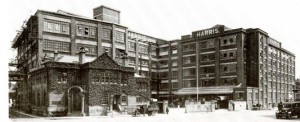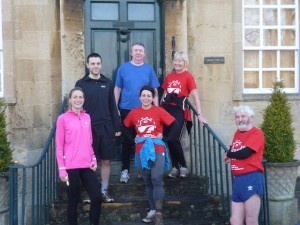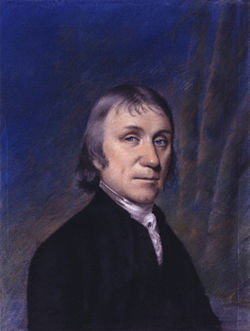| Date | Hare | Scribe |
|---|---|---|
| 17 Feb 2013 | Des | Keith |
Today the trail was laid by Des and his son Matt, and we were treated to a trail in the less explored area around Calne. And what a treat it was. Who would have guessed how lovely are the environs around this once industrialised pig-processing Wiltshire backwater? But the Harris factory has long gone (1983) along with the associated noise and smells that went with it. Now Calne is shiny and modern, but with plenty of historical interest, as we shall see.

Des promised us a trail less muddy than on Colin’s hash 2 weeks before (which would not be hard to achieve would it?). Whereas that hash scored 15 out of 10 for muddiness, Des reassured us that his hash only scored an 8. And so it was. I ran with Brian at one point, who lost his trainer in deep mud behind me. I heard his anguished yelp as the mud took its hold of his shoe. I then gave up bothering trying to keep feet/trainers dry. But it was as nothing compared with the memorably awful (unique?) conditions of 2 weeks ago. Note to GOM: how about certificates of attendance for that hash along the lines of “I was there…”?
Back to today’s hash then. Cold, crisp and clear, a beautiful spring-like morning, with mostly blue sky. Snowdrops on the trail, which took us through wooded areas beside streams running through Calne itself and past some of the older properties. Des had promised us an ‘odd’ marking in flour that we would have to make sense of.
 Outside a rather grand townhouse we came across an O2 sign (nothing to do with mobile phones though). Fortunately we had Mike with us, who deciphered this clue in short order, explaining the nearby house , with a “Priestley” nameplate, meant that here had lived a man (Joseph Priestley 1733-1804) of that name who had discovered oxygen, which he (not very snappily) termed “dephlogisticated air”.
Outside a rather grand townhouse we came across an O2 sign (nothing to do with mobile phones though). Fortunately we had Mike with us, who deciphered this clue in short order, explaining the nearby house , with a “Priestley” nameplate, meant that here had lived a man (Joseph Priestley 1733-1804) of that name who had discovered oxygen, which he (not very snappily) termed “dephlogisticated air”.
 Wikipedia tells us that Priestley lived in Calne from 1773-1780. He was obviously a prodigiously talented individual, being a natural philosopher, scientist (also discovered sulphur dioxide), and could speak many languages (French, Italian, and German in addition to Chaldean, Syrian, and Arabic). By the time he died in 1804, Priestley had been made a member of every major scientific society in the Western world and had discovered numerous substances. And all this from eating a diet of pork sausages.
Wikipedia tells us that Priestley lived in Calne from 1773-1780. He was obviously a prodigiously talented individual, being a natural philosopher, scientist (also discovered sulphur dioxide), and could speak many languages (French, Italian, and German in addition to Chaldean, Syrian, and Arabic). By the time he died in 1804, Priestley had been made a member of every major scientific society in the Western world and had discovered numerous substances. And all this from eating a diet of pork sausages.
The area around Calne on which we trod was reasonably level throughout though Des and Matt had managed to take us gently upwards towards lovely views of the surrounding area. There were 7 runners in all, a similar number of walkers, and our options were to follow short, medium or long trails, the latter being 5.5 miles.
Margaret had eaten her shredded wheat for breakfast and was off, impressively, towards the front of the pack, where she remained throughout with our three younger fellow-hashers, leaving Brian and I at the back. Margaret’s secret? No, not performance enhancing drugs, but exercise. She’d been out walking twice in the days before, 10 and 7 miles, so now we know how to improve our own hash performances. But despite being turbo-charged today, Margaret was still caught out cutting a corner (told you I’d put that in Margaret!).
There was no hash horn or hash shorts to award today. The hash trail was well-laid throughout and a thoughtful, interesting trail it was. Our thanks go to Des and Matt.

Thanks Keith… but this really hurts my brain… aren’t we suppposed to be taking things easier at our age?!!?
Hi Kathy. I thought someone would ask, but as I never had time to look it up, I couldn’t say what Chaldean is. Until now…..
Just consulted Wikipedia who say….
“Chaldean Neo-Aramaic is one of a number of modern Northeastern Aramaic languages spoken in the region of Kurdistan, between Lake Urmia in Iranian Azerbaijan in northern Iraq near Dohuk and near the Turkish border. Jews and Christians speak different dialects of Aramaic that are often mutually unintelligible. The Christian dialects have been heavily influenced by Classical Syriac, the literary language of Syriac Christianity in antiquity. Therefore Christian Neo-Aramaic has a dual heritage: literary Syriac and colloquial Eastern Aramaic. The Christian dialects are often called Soureth, or Syriac. In Iraqi Arabic. Speaks Aramaic new Chaldean, mostly in the mountainous regions of Iraq, as well as the Chaldean language they speak in Basra, Babil, Baghdad and other Iraqi provinces”
This is much more than I care to know….
best wishes. Keith.
Very poetic, Keith. Sorry I missed it, but reading your imaginative prose is the next best thing. But Chaldean?… What country’s that from…? Or am I very ignorant? and I never knew that Syria had its own language, either. The amazing things you learn when you go hashing!